Lied vom Hürnen Seyfrid
Das Lied vom Hürnen Seyfrid (the song of horn-skinned Siegfried), or Hürnen Seyfrid for short, is an anonymous Early New High German heroic ballad. The poem concerns the adventures of young Siegfried, hero of the Nibelungenlied. It preserves traditions about Siegfried that are otherwise only known from Old Norse sources and thus attest their existence in oral traditions about Siegfried that circulated outside of the Nibelungenlied in Germany.
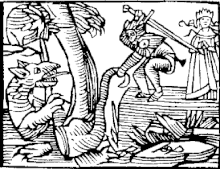
Hürnen Seyfrid tells how Siegfried was raised by a smith, killed a dragon, and made his skin invincible (got his skin as hard as horn (hürnen)). Afterwards it tells how he rescued Kriemhild, daughter of the Burgundian king Gybich, with the help of the dwarf Eugel from a cursed man who has transformed into a dragon. In doing so, Siegfried fights the giant Kuperan. In defeating the dragon, Siegfried acquires the treasure of the Nibelungen and marries Kriemhild.
The poem, together with another heroic ballad, the Jüngeres Hildebrandslied, is the piece of German heroic tradition that remained popular the longest and the only part of the tradition surrounding the Nibelungenlied to enter early print culture. The poem was printed into the eighteenth century, and a prose version continued to be printed into the nineteenth century.
Summary
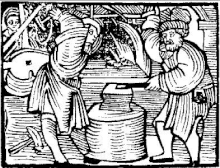
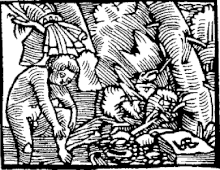
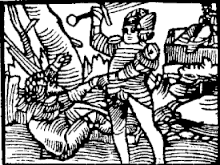
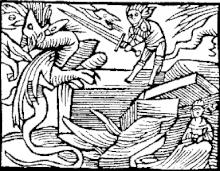
Seyfrid (or Sewfrid), son of king Sigmund, is sent away from his father's court due to his bad behavior. He comes across a smith in a village who takes him as his apprentice, but Seyfrid destroys the anvil with his sword and abuses the other apprentices and the smith himself. The smith therefore sends Seyfrid to a loan linden tree under the pretense that the boy will meet a charcoal burner there. In reality, the smith has sent Seyfrid to the linden tree because a dragon lives next to the tree, and the smith hopes that the dragon will kill the boy. Seyfrid, however, kills the dragon easily and then, looking for the charcoal burner, wanders into a forest where he encounters many dragons in a clearing. Seyfrid rips up trees and throws them at the dragons, trapping them. He finally finds the charcoal burner, and with his help he lights the trees over the dragons on fire, killing them. Their horned-skin (that is, impenetrable skin) melts from the heat and flows as a small stream. Seyfrid sticks his finger into it and realizes that it causes his own skin to harden, so he smears the melted horned-skin over himself, covering everywhere except between his shoulder blades. Later, the poem tells us, Seyfrid will go to the court of King Gybich in Worms, in order to marry Gybich's daughter Kriemhild. He will also find the treasure that Nibelung, king of the dwarfs, had hidden away in a mountain for his sons. Because of this treasure there was a great slaughter among the Huns, which only Dietrich von Bern and Hildebrand survived.
In Worms, meanwhile, king Gybich rules with his three sons Gunther, Gyrnot, and Hagen, along with his daughter Kriemhild. One day a dragon appears, seizes the girl and flies away with her to the mountain Trachenstein. The dragon does not mistreat Kriemhild, however, laying his head in her lap. At Easter he transforms into a man. Kriemhild asks him for permission to see her family, promising to return, but he tells her she must remain with her for five years, after which he will sleep with her and take her away with him to hell. The man turns back into a dragon, and Kriemhild prays. Gybich, meanwhile, has sent messengers out to search for his daughter.
Seyfrid is out hunting one day when his dogs pick up the scent of the dragon. He follows it, but when he finally sees the dragon he is afraid and wants to run away. But Eugel, king of the dwarfs, now appears and addresses Seyfrid with his own name. Seyfrid, realizing that Eugel knows something about him, asks Eugel for the name of his parents, whom he has forgotten. The dwarf causes him to remember and also tells him about the dragon and Kriemhild. Seyfrid then decides to fight; Eugel tries to dissuade him, but Seyfrid forces the dwarf to help him. Eugel tells him that the giant Kuperan lives nearby, who has the key to the mountain. Kuperan and Seyfrid fight, but Seyfrid wounds the giant, whom he spares in exchange for help freeing Kriemhild. Yet while they are riding through the forest, Kuperan attacks Seyfrid, knocking him unconscious. Eugel covers Seyfrid with his cloak of invisibility to save him until Seyfrid regains consciousness. Seyfrid then attacks Kuperan and wants to kill him, but spares him so that they can enter the mountain. Once they reach the mountain, Kuperan lets Seyfrid in and Seyfrid commands him to leave.
Seyfrid finds Kriemhild and wishes to take her away, but Kuperan comes back now, armed with a sword that can cut even dragon skin. Despite receiving grievous wounds, Seyfrid is able to push the giant off of Trachenstein. Eugel now discovers that Seyfrid has eaten nothing for four days and summons his dwarfs to bring him food. Just now the dragon returns, however, and we are told that it was originally a man who was cursed by a woman in a lover's quarl, becoming a dragon and being possessed by the devil. He can only become a man again if he has spent five years with a woman at his side. Seyfrid fights with the dragon, but has to flee the heat of the dragon's fire and together with Kriemhild goes deeper into the mountain. There he finds the treasure of Nibelung, who is Eugel's father. Eugels brothers had hidden it there from the giants. Seyfrid now fights with the dragon once more, killing him and cutting him to pieces which he throws from the mountain. Seyfrid can no longer see or hear and doesn't know where he is, his face is pale and his mouth is black. He falls unconscious. When he wakes up, he discovers that Kriemhild has also fallen unconscious. Eugel gives him an herb, which wakens her. The dwarf then thanks Seyfrid for freeing him from Kuperan and brings him to his kingdom. Seyfrid asks Eugel to tell him his future: the dwarf responds that Seyfrid will be murdered in eight years, but Kriemhild will avenge him. On his way out of the mountain Seyfrid takes the treasure without realizing it belongs to Eugel. As Seyfrid approaches Worms he thinks how little use the treasure will be to him as he will soon die, and dumps it into the Rhine.
Seyfrid is well received in Worms and marries Kriemhild, ruling together with Gybich's children, but soon Kriemhild's brothers begin to hate him and later on they kill him at a spring. The ballad ends by stating that anyone who wishes to learn more should read "Kriemhild's Wedding".[1][2]
Origins, transmission, and dating
Hürnen Seyfrid and Ermenrichs Tod are the only German heroic poems not found transmitted in any manuscript. It is possible that the poem already existed around 1400, however, as version m of the Nibelungenlied appears to incorporate details from Hürnen Seyfrid.[3] The Nibelungenlied n also references details from the poem, as do a version of the Rosengarten zu Worms and of Ortnit. The current form of the poem likely came into being around 1500, possibly in Nuremberg.[4] Twelve printed editions of Hürnen Seyfrid are known from the sixteenth and seventeenth centuries. The earliest is from 1530, but is possible that it was not the first. In 1561 the text was reworked stylistically, and this is the version that was found in later printings.[3] Many of the editions feature woodcuts.[4]
The poem was rewritten as prose in 1657 with the change of a few names (Kriemhild becomes Florigunda) and with the addition of a few episodes. This version even inspired a sequel in 1660, telling the story of Seyfrid's son with Florigunda, Lowhard.[5] This version continued to be printed into the nineteenth century,[4] though it dramatically changed elements of the poem, particularly concerning "Kriemhild's" revenge for Siegfried, which mostly falls to Siegmund (in the printing "Sieghardus").[6]
Relationship to the Nibelungenlied and oral tradition
Hürnen Seyfrid features numerous details that are known from the Nordic traditions about Sigurd that are absent in the Nibelungenlied. Among these are that Hagen is one of the sons of Gybich, as he is in the Nordic poems Atlakviða and the Thidrekssaga, that Gybich is the name of the king of Worms rather than Dancrat as in the Nibelungenlied, and that Siegfried is raised by a smith who tries to have him killed by a dragon. This is generally taken to mean that the poet had access to an oral tradition outside of the Nibelungenlied which featured these elements.[7][8][4] The poet of the Nibelungenlied, on the other hand, seems to have deliberately suppressed many elements that appear in Hürnen Seyfrid, and reports on Siegfried's killing of the dragon and his invincibility only very briefly and in retrospect.[9]
Metrical Form
Hürnen Seyfrid is written in the so-called "Hildebrandston", a stanzaic metrical form named after its use in the Jüngeres Hildebrandslied that had an accompanying melody. The stanza consists of four "Langzeilen", lines consisting of three metrical feet, a caesura, and three additional metrical feet. Unlike the similar stanza used in the Nibelungenlied, in the "Hildebrandston" all four lines are of the same length. The lines rhyme in couplets, with occasional rhymes across lines at the caesura.[10] In the printed versions of Hürnen Seyfrid, these "Langzeilen" have been split up at the caesura into eight shorter lines.[4] An example is the first stanza of a 1642 printing:
- Es saß im Niderlande/ x
- Ein König so wol bekandt/ a
- Mit grosser Macht vnnd Gewalte x
- Sigmund ward er genand/ a
- Der hät mit seiner Frawen/ x
- Ein Sohn/ der heist Säwfried/ b
- Deß Wesen werd jhr hören/ x
- Allhie in diesem Lied. b
Aesthetic quality and popular success
Scholars frequently decry Hürnen Seyfrid's artistic deficiencies: the plot has many inconsistencies and the verse is of low quality. The poem appears to have been haphazzardly put together from various parts.[11][12] The poem does not problematize any of Siegfried's actions and has a deeply Christian background in which Siegfried represents good and the giants and dragons represent evil.[13] Despite these modern complaints, the poem was very popular and the longest lasting representative of the heroic tradition in Germany. Victor Millet notes that this poem was the first chance many early modern readers had ever gotten to read about the adventures of the famous hero Siegfried, as the Nibelungenlied itself was never printed. Effectively, the more exciting and less intellectually complicated Hürnen Seyfrid seems to have replaced the Nibelungenlied.[14] Werner Hoffmann suggests that Hürnen Seyfrid's popularity in the Early Modern Period may owe some to its quality as exciting escapist fiction at a time when the Holy Roman Empire was rocked by repeated political instability and religious conflict.[15]
The poem's success led to it being translated into other genres: Hans Sachs wrote a tragedy in seven acts in 1557 called Der hürnen Seufrid, which also featured elements from the Rosengarten zu Worms and the printed Heldenbuch.[6] A version of the poem was also contained in a work by the humanist and Lutheran pastor Cyriacus Spangenberg, Der ander Teil des Adelsspiegels (1594), which is cited by Melchior Goldast from a lost printing in 1604. In 1615, the poem was translated into Czech, in 1641 into Dutch.[16]
Notes
- Millet 2008, pp. 467-469.
- Haymes & Samples 1996, pp. 129-130.
- Millet 2008, p. 467.
- Lienert 2015, p. 67.
- Millet 2008, p. 471.
- Lienert 2015, p. 70.
- Hoffmann 1974, pp. 101-102.
- Millet 2008, p. 469.
- Hoffmann 1974, pp. 95-96.
- Heinzle 1999, pp. 85-86.
- Hoffmann 1974, pp. 98-98.
- Lienert 2015, p. 68.
- Lienert 2015, pp. 68-69.
- Millet 2008, pp. 470-471.
- Hoffmann 1974, pp. 98-100.
- Lienert 2015, pp. 70-71.
Editions
- Golther, Wolfgang, ed. (1911). Das Lied vom Hürnen Seyfrid nach der Druckredaktion des 16. Jahrhunderts. Mit einem Anhange Das Volksbuch vom gehörnten Siegfried nach der ältesten Ausgabe (1726). Halle: Niemeyer.CS1 maint: ref=harv (link)
- King, Kenneth Charles, ed. (1958). Das Lied vom Hürnen Seyfrid. Critical Edition with introduction and notes. Manchester: Manchester University.CS1 maint: ref=harv (link)
- Verio Santoro: La ricezione della materia Nibelungica tra Medioevo ed Età moderna: Der hürnen Seyfrid. Salerno: Laveglia 2003. ISBN 88-88773-04-5.
References
- Gillespie, George T. (1973). Catalogue of Persons Named in German Heroic Literature, 700-1600: Including Named Animals and Objects and Ethnic Names. Oxford: Oxford University. ISBN 9780198157182.CS1 maint: ref=harv (link)
- Haymes, Edward R.; Samples, Susan T. (1996). Heroic legends of the North: an introduction to the Nibelung and Dietrich cycles. New York: Garland. pp. 129–131. ISBN 0815300336.
- Heinzle, Joachim (1999). Einführung in die mittelhochdeutsche Dietrichepik. Berlin, New York: De Gruyter. ISBN 3-11-015094-8.CS1 maint: ref=harv (link)
- Hoffmann, Werner (1974). Mittelhochdeutsche Heldendichtung. Berlin: Erich Schmidt. pp. 95–107. ISBN 3-503-00772-5.CS1 maint: ref=harv (link)
- Lienert, Elisabeth (2015). Mittelhochdeutsche Heldenepik. Berlin: Erich Schmidt. pp. 67–71. ISBN 978-3-503-15573-6.CS1 maint: ref=harv (link)
- Millet, Victor (2008). Germanische Heldendichtung im Mittelalter. Berlin, New York: de Gruyter. pp. 466–471. ISBN 978-3-11-020102-4.CS1 maint: ref=harv (link)
External links
Facsimiles
"Hürnen Saewfried Gesangweiß" (1642 printing)